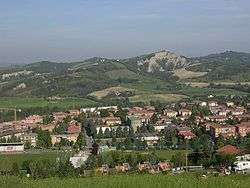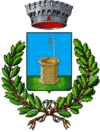Pianoro
| Pianoro | ||
|---|---|---|
| Comune | ||
| Comune di Pianoro | ||
 | ||
| ||
 Pianoro Location of Pianoro in Italy | ||
| Coordinates: 44°23′15″N 11°20′40″E / 44.38750°N 11.34444°E | ||
| Country | Italy | |
| Region | Emilia-Romagna | |
| Province / Metropolitan city | Bologna (BO) | |
| Frazioni | Carteria, Gorgognano, Guzzano, Livergnano, Montecalvo, Montelungo, Musiano, Pian di Macina, Pianoro Nuovo, Pianoro Vecchio Rastignano, Sesto | |
| Government | ||
| • Mayor | Gabriele Minghetti | |
| Area | ||
| • Total | 107 km2 (41 sq mi) | |
| Elevation | 200 m (700 ft) | |
| Population (30 November 2008) | ||
| • Total | 17,107 | |
| • Density | 160/km2 (410/sq mi) | |
| Demonym(s) | Pianoresi | |
| Time zone | CET (UTC+1) | |
| • Summer (DST) | CEST (UTC+2) | |
| Postal code | 40065 | |
| Dialing code | 051 | |
| Patron saint | Assumption of Mary | |
| Saint day | August 15 | |
| Website | Official website | |
Pianoro is a town and comune in the province of Bologna in the Emilia-Romagna region of Italy, in the hills of the Tusco-Emilian Apennines, 200 metres (660 ft) above sea level.
Highway SS 65 connects the town to Bologna and Florence across the Apennines. Pianoro has a local railway station with connections to Florence and Bologna.
History
According to legend the Etruscan king Ocno (also known as Bianore, mythical founder of Felsina and other cities), lived in the area. There is evidence of Celtic and Etruscan settlement at the Monte Bibele archeological site. The Roman presence in the area is seen in the names of local villages such as Sesto.
Bonifacio of Canossa, feudal lord of Pianoro during the 11th century, used to live in the Castle of Pianoro, subsequently demolished by the inhabitants of Bologna who accused the people of Pianoro of conspiracy.
During World War II the town was heavily bombed by Anglo-American forces. The Gothic Line was very close and in October 1944 there was a huge battle (in Livergnano) involving German, American forces and local partisans, leaving on the ground thousands of Anglo-American soldiers. Civil engineers reported that 98.5 percent of the town was destroyed during the battle. Many German soldiers are buried in the German Military Cemetery and War Memorial at the Futa pass, a few kilometers south of the town in the direction of Florence.
The town was rebuilt 3 kilometres (2 mi) north of the old site, toward Bologna. The new town is called Pianoro Nuovo (New Pianoro) and the remains of the old are called Pianoro Vecchio (Old Pianoro).
Economy
Industries located in the area are primarily in the mechanical engineering (Marchesini Group and MG2) and chemicals (Sayerlack S.r.l.)sectors
Landscape and tourism
The Gessi Bolognesi e Calanchi dell'Abbadessa Park, shared with San Lazzaro di Savena, contains an area of karstic topography with dolines, badlands and cliffs. There are many trails used by walkers and trekkers.
They also have the most successful cricket team of recent times, winning the Serie A 12 Times, the Italian Goblet 14 times and the European Championship once, in 1995.
External links
- Official website
- Googlemap: Pianoro as seen from the satellite
- Gessi Bolognesi e Calanchi dell'Abbadessa Park
- Marchesini Group
- MG2
- SAYERLACK S.r.l.
